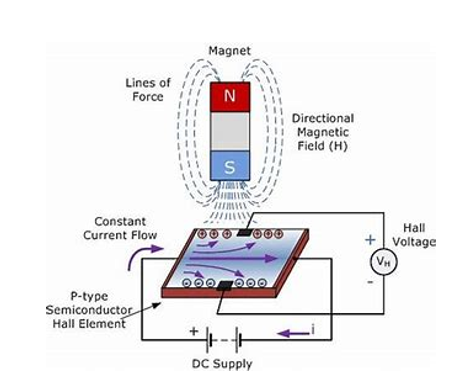To study Hall effect and determine hall coefficient , carrier density and mobility of a given semiconductor material using hall effect Set up
Hall Effect:
The principle of the Hall effect states that when a current-carrying conductor or a semiconductor is introduced to a perpendicular magnetic field, a voltage can be measured at the right angle to the current path. This effect of obtaining a measurable voltage is known as the Hall effect.
The Hall voltage represented as VH is given by the formula:
 Here,
Here,I is the current flowing through the sensor
B is the magnetic field strength
q is the charge
n is the number of charge carriers per unit volume
d is the thickness of the sensor.
When a conductive plate is connected to a circuit with a battery, then a current start flowing. The charge carriers will follow a linear path from one end of the plate to the other end. The motion of charge carriers results in the production of magnetic fields. When a magnet is placed near the plate, the magnetic field of the charge carriers is distorted. This upsets the straight flow of the charge carriers. The force which upsets the direction of the flow of charge carriers is known as Lorentz force.
Due to the distortion in the magnetic field of the charge carriers, the negatively charged electrons will be deflected to one side of the plate and positively charged holes to the other side. A potential difference, known as the Hall voltage will be generated between both sides of the plate which can be measured using a metre.

Calculation of Hall effect coefficient:
Calculation of carrier density

Where n is the number of charge carrier density.
Charge Carriers
In a conductive material, such as a metal or a semiconductor, electric current is carried by mobile charge carriers. These carriers can be electrons (negatively charged) or holes (positively charged vacancies in the electron sea).
Mobility
Mobility refers to the ease with which charge carriers move in response to an electric field. It quantifies the speed and efficiency of charge carrier movement under the influence of an electric field.
It's important to note that mobility is a material property and is influenced by factors such as the density of charge carriers, the crystal structure of the material, and the presence of impurities or defects.
Data for determining the Hall voltage or current
| Trial. No | Magnetic Field (Tesls T) | Thickness (t)m | Hall current (ma) | Hall Voltage | RH |
|---|---|---|---|---|---|
| 1. | |||||
| 2. | |||||
| 3. | |||||
Data for determining the ammeter reading and voltmeter |
|||||
| Sr. No | Trial No: | Current through solenoid | Magnetic field generated | ||
| :-- | :-- | :-- | :-- | ||
| 1. | |||||
| 2. | |||||
| 3. | |||||

